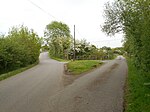Newbold Revel

Newbold Revel refers to an existing 18th-century country house and a historic manorial estate in North East Warwickshire. In the fifteenth century, the estate was the home of the medieval author Sir Thomas Malory. The house is today used by HM Prison Service as a training college; it is a Grade II* listed building. Historically, the Newbold Revel estate and house formed a significant part of the parish of Monks Kirby. Today the country house is in the modern parish of Stretton-under-Fosse, in the borough of Rugby. The current house was built in 1716 for Sir Fulwar Skipwith, 2nd Baronet and was constructed of brick in three stories to an H-shaped plan with an 11-bay frontage. In the late 19th century the ground floor was extended forwards.
Excerpt from the Wikipedia article Newbold Revel (License: CC BY-SA 3.0, Authors, Images).Newbold Revel
Main Street,
Geographical coordinates (GPS) Address External links Nearby Places Show on map
Geographical coordinates (GPS)
| Latitude | Longitude |
|---|---|
| N 52.4234 ° | E -1.332 ° |
Address
Prison Service College Newbold Revel
Main Street
CV23 0PZ
England, United Kingdom
Open on Google Maps








